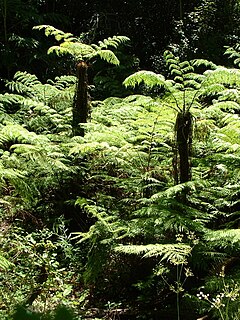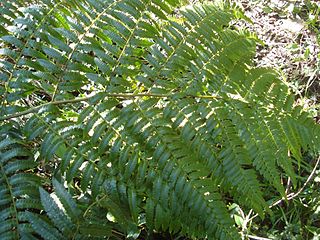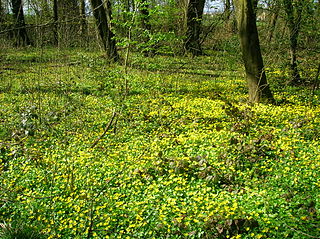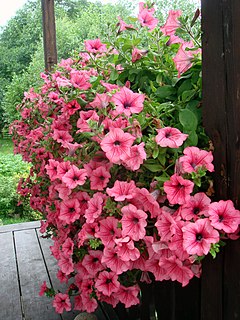Cyathea alpicola is a species of tree fern native to central Sumatra, where it grows in montane rain forest at an altitude of 2000–2750 m. The erect trunk can reach 5 m or more in height. Fronds are bi- or tripinnate and usually 2–3 m long. They have a tendency to persist on the plant after withering, forming an irregular skirt around the trunk. This species has a spiny stipe, which is covered with a woolly layer of scales. There appear to be two forms with different scales; either dark glossy brown with a broad paler margin and fragile edges, or small, brown and finely fringed. Sori are covered by thin, fragile indusia and occur near the midvein of fertile pinnules. The closest relative of C. alpicola is thought to be Cyathea polycarpa, which differs by lacking spines altogether. Cyathea macropoda and Cyathea magnifolia may also be closely allied with this species.
Cyathea atropurpurea is a species of tree fern native to the islands of Luzon, Mindanao, Leyte and Mindanao in the Philippines, where it grows in forest at above 1000 m. The erect trunk is slender and may be up to 3 m tall. Fronds are bipinnate and 1–2 m long. Characteristically of this species, the final pair of pinnae are usually reduced and occur towards the base of the stipe. These, along with the stipe bases, are persistent and retained around the trunk long after withering. The stipe itself is dark and covered with scales, which are either small, dull and brown or large, dark and glossy. Sori occur near the midvein of fertile pinnules and lack indusia. Fertile pinnules are notably smaller than sterile ones.

Cyathea australis, also known as the Rough Tree Fern, is a species of tree fern native to southeastern Queensland, New South Wales and southern Victoria in Australia, as well as Tasmania and Norfolk Island.
Cyathea baileyana, also known as the wig tree fern, is a species of tree fern native to northeastern Queensland in Australia, where it grows in wet gullies and forest at an altitude of 850–1200 m. It is a rare species that is seldom found in the wild. The erect trunk is 4–5 m tall, approximately 10 cm in diameter and may be covered in stipe bases in the upper regions. C. baileyana is notable for being able to develop offshoots from the base of the trunk. Fronds are bi- or tripinnate and may be exceptionally long, up to 7 m, though they are usually around 2–3 m. The rachis and stipe are dark to darkish red, scaly and may be warty, but lack spines. Scales on the rachis and stipe are purplish brown to black and have a long hair-like apex. Characteristically of this species, the last pair of pinnae are separated from the others along the rachis and may form a clump around the trunk apex. Sori are circular and occur in one to three rows along the pinnule midvein. They lack indusia.

Cyathea brevipinna is a species of tree fern endemic to the higher parts of Mount Gower on Lord Howe Island, where it grows in exposed areas at an altitude of about 790 m. The trunk is erect and may reach 3 m in height. It is often covered with reddish brown scales and stipe bases. This species may produce stolons at ground level. Fronds are tripinnate, densely crowded, and up to about 3 m long. The stipe is brown and sometimes warty after scales fall off. The scales are long, glossy dark brown, with a distinctly narrow apex and fragile paler edges. Sori are attached to deeply divided fertile pinnules that may uncurl over the sori. Indusia are firm and large. C. brevipinna is a stunted plant with short pinnae.

Cyathea capensis is a regionally widespread and highly variable species of tree fern. It is indigenous to Southern Africa and South America.

Cyathea colensoi, also known as the Creeping Tree Fern, Mountain Tree Fern and Golden Tree Fern, is a species of tree fern native to New Zealand, from the southern part of the North Island south to Stewart Island. It grows in submontane to montane forest in damp areas, particularly near the tree line. The trunk is usually prostrate, but may sometimes be erect. It may reach about 1 m in height. Fronds are tripinnate and about 1.5 m long or more. The rachis and stipe are slender, pale brown and are covered with brown scales. Sori occur in two rows, one along each side of the fertile pinnule midvein, and lack indusia. Plants form a thicket with no sign of a trunk.
Cyathea costulisora is a species of tree fern native to Sumatra. The trunk is erect and usually 1–4 m tall. Fronds are bi- or tripinnate and 1–2 m long. The stipe is covered with warts and scales. The scales are either pale and glossy or dark and flat. Sori occur near the fertile pinnule midvein and are covered by large, firm, brown indusia.
Cyathea cuspidata is a widespread species of tree fern native to Central and South America, where it grows in tropical rain forest up to the montane zone, as well as in open sites, on riverbanks and cleared pastureland at an altitude of 0–800 m. Its natural distribution covers Mexico, Guatemala, Belize, Honduras, El Salvador, Nicaragua, Costa Rica, Panama, Colombia, Ecuador, Peru, Bolivia, Paraguay, the Amazon Basin, Brazil and French Guiana. This species often has multiple trunks, which may be 15 m tall and about 10 cm in diameter. They are covered in black spines and together form a medium-sized, feathery clump. Fronds are bipinnate and 2–3 m long. The rachis and stipe are brown to dark brown and are covered with scales. The scales are bicoloured, having a dark brown to blackish centre and a pale, whitish margin. Pinnule veins sometimes have small, brown, star-shaped scales. Sori are round and form on either side of the pinnule midvein. They are covered by globose indusia.

Cyathea dregei is a widespread species of tree fern in southern Africa.
Cyathea esmeraldensis is a species of tree fern which is endemic to Ecuador. It grows in coastal forest and forested slopes of the Andes.
Cyathea fenicis is a species of tree fern native to the Philippines, Taiwan, and Orchid Island, where it grows in wet forest, forest margins and on hillsides. The trunk is erect, up to 1 m tall and about 6 cm in diameter. Fronds are tripinnate and 1.5–2 m long. Characteristically of this species, the lowest pinnae are usually reduced. The stipe is spiny and ranges in colour from brown to purple-dark brown. It bears two types of scales: long dark brown scales as well as minute brown ones. Occasionally the scales are pale. Sori are round and arranged in two rows, one on either side of the pinnule midvein. They are covered by very small indusia that resemble scales in appearance.
Cyathea ferruginea is a species of tree fern endemic to the Philippines.
Cyathea glaberrima is a species of tree fern endemic to the D'Entrecasteaux Islands, specifically Fergusson Island and Goodenough Island, where it grows in mossy forest at an altitude of 900–1,400 m (3,000–4,600 ft). The trunk is erect and usually about 2 m tall. Fronds may be bi- or tripinnate, are 1–2 m in length, and form a dense crown. The stipe is finely warty and bears numerous glossy scales with fragile edges. Sori are produced close to the fertile pinnule midvein. They are protected by small, dark brown indusia that are scale-like in appearance.
Cyathea hancockii is a species of tree fern native to the Ryukyu Islands, Japan, Taiwan and Hong Kong. The specific epithet hancockii commemorates William Hancock (1847-1914), who collected numerous plants in Japan, China and Southeast Asia. It grows in forest, on stream banks, and in forest margins at an elevation of about 600 m or higher.

Cyathea delgadii is a widespread species of tree fern native to Costa Rica, Panama, Venezuela, French Guiana, Guyana, Trinidad, Colombia, Ecuador, Peru, Bolivia, Argentina, Paraguay, and Brazil.
Cyathea × marcescens, commonly known as the skirted tree fern, is a tree fern endemic to the Cape Otway ranges in Victoria and Tasmania, Australia. It is a natural hybrid, apparently Cyathea australis × Cyathea cunninghamii. Braggins and Large (2004) note that it has characteristics midway between these two species. The spores of C. × marcescens are usually malformed although sterile. The trunk of this plant is erect and up to 10 m tall. Fronds may be bi- or tripinnate and 3–4 m in length. Dead fronds often persist, forming a characteristic skirt around the trunk. The stipe is thick, black and warty. The rachis and trunk are covered in shiny, dark brown scales. Sori are borne near the fertile pinnule midvein and are protected by thin indusia that are saucer-like in appearance.
Cyathea imrayana is a species of tree fern native to Dominica, Costa Rica, Panama, Venezuela, and Ecuador.
Cyathea latebrosa is a common and widespread species of tree fern native to Indochina. Its natural range covers Cambodia and Thailand, and stretches from the Malay Peninsula to Indonesia, where it is present on the islands of Borneo and Sumatra. Plants reported from India and Sri Lanka have thinner indusia and may represent a separate, as-yet undescribed, species. C. latebrosa grows in a wide range of habitats, including forest, secondary forest, and plantations, from sea level up to an elevation of about 1500 m.
Cyathea ledermannii is a species of tree fern native to Papua New Guinea and Bougainville Province in the Solomon Islands, where it is common in submontane rain forest at an altitude of 1000–3000 m. The trunk of this plant is erect and grows to about 3 m in height. Fronds may be bi- or tripinnate and up to 2 m in length. The rachis is purplish brown in colouration and usually bears basal scales. These scales range from pale, to brown, to bicoloured. Sori are borne on each side of the pinnule midvein. They are protected by firm indusia.















